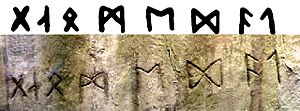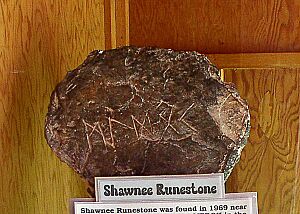Oklahoma runestones facts for kids
Runestones are stones with special ancient writing called runes. These runes were used by people in northern Europe, like the Vikings. In Oklahoma, some stones have been found that look like runestones. However, most experts believe these stones were made more recently. Some might have been made in the 1800s by Scandinavian settlers. Others could be part of a "Viking revival" interest from that time.
The oldest stone found is the "Heavener Runestone." It was first written about in 1923. Two other "Heavener Runestones" are probably not runes at all. They might be carvings made by Native Americans. Other stones found in Poteau, Shawnee, and Pawnee are also thought to be modern.
Heavener Runestone
The Heavener Runestone is located in Heavener Runestone Park. This park is near Heavener, Oklahoma, in Le Flore County, Oklahoma.
The runes on the stone spell out ᚷᛆᛟᛗᛖᛞᚨᛐ. Most of these letters are from an old runic alphabet called Elder Futhark. But one letter, the "A," is from a newer alphabet called Younger Futhark. The last letter is also reversed.
People usually think the stone was meant to spell gnomedal. This could mean "gnome valley" or be a person's name, "G. Nomedal." The park's visitor center suggests it might mean "valley belonging to Glome," or "Glome's Valley." This would have been a way to claim land.
Why Experts Doubt It's Ancient
Archaeologist Ken Feder points out that there is no other proof of Vikings in Oklahoma. For example, in eastern Canada, real Viking sites like L'Anse-aux-Meadows have been found. These sites have tools and buildings. Nothing like that has been found near Heavener. Feder believes it is unlikely that Vikings would have left only one stone behind.
Lyle Tompsen, another archaeologist, studied the Heavener Runestone. He wrote about his findings in 2007.
- There is no other cultural evidence of Vikings in the area.
- The way the runes are written does not match old Norse translations.
- The most likely meaning of the stone is 'Gnome Dale' (Valley of the Gnomes).
- There were Scandinavian people living in Heavener early on. They are the most likely people to have carved the stone.
- Other stones thought to be runestones in the area are either modern or Native American art.
Tompsen concludes that the Heavener stone is best seen as a modern creation.
Henrik Williams is a professor who studies Nordic languages. He visited Oklahoma in 2015. He said the Heavener stone is impressive because of its size. However, he believes it is probably from the 19th century. He thinks there is only a small chance it could be from the 10th or 11th century.
Professor Williams noted that old runic words always had special endings. The Heavener Runestone does not have these endings. He also said that old Viking inscriptions usually had certain designs. The American inscriptions found do not fit this pattern. He also pointed out that there are no Viking inscriptions in Iceland or Greenland. This makes it a very big jump for Vikings to have made it to Oklahoma.
In 1991, Carl Albert State College in Poteau changed its mascot to a Viking. They did this to honor the Heavener Runestone.
Poteau Stone
The Poteau stone was found in 1967. Schoolboys discovered it near Poteau, Oklahoma, in LeFlore County, Oklahoma.
Lyle Tompsen also studied this stone. It is carved into sandstone and is about 15 inches long. The carving does not look very old or worn by weather. The runes on the stone are ᚷᛆᛟᛁᛖᚨᛚᚦ. Tompsen says these letters are a mix of different alphabets from different times.
He noted that five of the eight letters are from the Elder Futhark. One is from the Younger Futhark. The other two letters he calls "spurious," meaning they don't seem to fit. Tompsen believes the Poteau Stone is a copy of the Heavener stone. He thinks someone added three extra symbols to it.
Swedish Professor Henrik Williams also believes the Poteau inscription is modern. He noted that the stone and tool marks do not look as weathered as they should if they were from the Viking period.
Shawnee and Pawnee Stones
The Shawnee stone was found in 1969. Three children discovered it in Shawnee, Oklahoma. It was found about a mile from the North Canadian River. This river flows into the Arkansas River.
Professor Don G Wyckoff, an archaeologist, looked at the Shawnee stone. He noted that it is made of soft red sandstone. He said the carving looks "remarkably fresh." It was not as worn as the natural surface of the stone. He had seen other carvings in this type of sandstone from as late as 1957 that looked more worn.
Both the Shawnee and Pawnee runestones are believed to be modern. The inscription on the Shawnee stone reads either mldok or midok using Elder Futhark letters.



